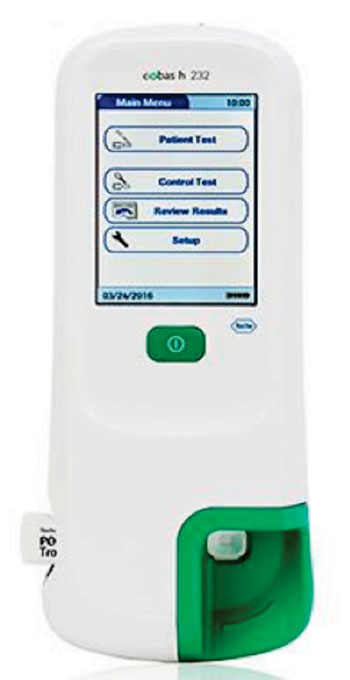Optimal Rule-Out Biomarker Strategy Developed for Acute MI
By LabMedica International staff writers
Posted on 27 Sep 2016
Assessment of patients presenting to the Emergency Department (ED) with symptoms suggestive of acute coronary syndrome (ACS) represents a major clinical challenge, since the majority of patients do not have a final diagnosis of acute myocardial infarction (AMI).Posted on 27 Sep 2016
A multi-marker strategy, combining high-sensitivity troponins (hs-cTn) with an early cardiac marker may improve sensitivity and increase the proportion of low-risk patients suitable for early discharge by allowing a higher troponin threshold to be utilized. Heart Fatty Acid Binding Protein (H-FABP), a highly myocardium-specific protein and early rise marker of ACS, is a potential candidate.

Image: The cobas h 232 POC system, designed for use with the Elecsys high sensitivity cardiac troponin (hs-cTnT) assay (Photo courtesy of Roche).
Scientists at the University of Otago (Dunedin, New Zealand) and their medical colleagues enrolled consecutive patients presenting acutely to the emergency department (ED) with symptoms suggestive of AMI. Patient assessment included blood sampling for contemporary TnI (c-TnI) at presentation and six to 12 hours later. The primary end point was AMI during initial hospital attendance. AMI diagnosis was based on evidence of myocardial necrosis, together with clinical features consistent with myocardial ischemia (ischemic symptoms, ECG changes or imaging evidence).
Necrosis was diagnosed on the basis of a rising or falling pattern of the routine laboratory c-TnI (ARCHITECT c-TnI assay, Abbott Diagnostics, Lake Forest, IL, USA), with at least one value above 0.028 ng/mL. Hs-cTnI concentrations were measured on the ARCHITECT STAT platform. Hs-cTnT concentrations were measured with the Roche Elecsys hs-cTnT assay. H-FABP concentrations were measured with an immunoturbidimetric H-FABP assay on the ARCHITECT platform.
The team recruited 1,079 patients including 248 with AMI. H-FABP of less than 4.3ng/mL plus hs-cTnI of greater than 10.0 ng/L together with a negative ECG maintained more than 99% sensitivity for AMI whilst classifying 40.9% of patients as low-risk. The combination of H-FABP less than 3.9ng/mL and hs-cTnT of greater than 7.6ng/L with a negative ECG maintained the same sensitivity whilst classifying 32.1% of patients as low risk.
The authors concluded that in patients requiring rule-out of AMI, the addition of H-FABP to hs-cTn at presentation in the absence of new ischemic ECG findings may accelerate clinical diagnostic decision making by identifying up to 40% of such patients as low-risk for AMI on the basis of blood tests performed on presentation. If implemented this has the potential to significantly accelerate triaging of patients for early discharge from the ED. The study was published on August 31, 2016, in the journal BMC Emergency Medicine.
Related Links:
University of Otago
Abbott Diagnostics














